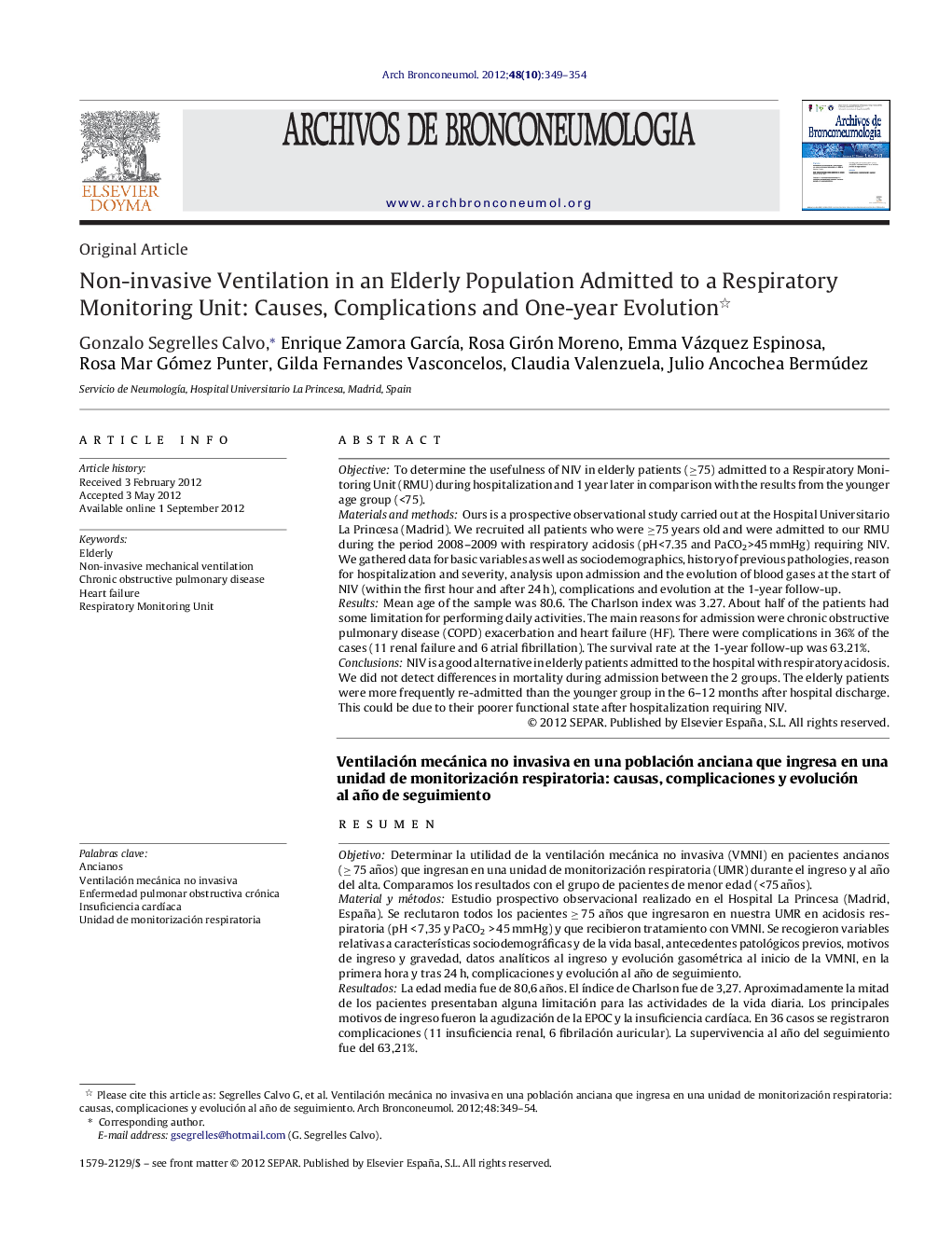| کد مقاله | کد نشریه | سال انتشار | مقاله انگلیسی | نسخه تمام متن |
|---|---|---|---|---|
| 4205864 | 1279941 | 2012 | 6 صفحه PDF | دانلود رایگان |

ObjectiveTo determine the usefulness of NIV in elderly patients (≥75) admitted to a Respiratory Monitoring Unit (RMU) during hospitalization and 1 year later in comparison with the results from the younger age group (<75).Materials and methodsOurs is a prospective observational study carried out at the Hospital Universitario La Princesa (Madrid). We recruited all patients who were ≥75 years old and were admitted to our RMU during the period 2008–2009 with respiratory acidosis (pH<7.35 and PaCO2>45 mmHg) requiring NIV. We gathered data for basic variables as well as sociodemographics, history of previous pathologies, reason for hospitalization and severity, analysis upon admission and the evolution of blood gases at the start of NIV (within the first hour and after 24 h), complications and evolution at the 1-year follow-up.ResultsMean age of the sample was 80.6. The Charlson index was 3.27. About half of the patients had some limitation for performing daily activities. The main reasons for admission were chronic obstructive pulmonary disease (COPD) exacerbation and heart failure (HF). There were complications in 36% of the cases (11 renal failure and 6 atrial fibrillation). The survival rate at the 1-year follow-up was 63.21%.ConclusionsNIV is a good alternative in elderly patients admitted to the hospital with respiratory acidosis. We did not detect differences in mortality during admission between the 2 groups. The elderly patients were more frequently re-admitted than the younger group in the 6–12 months after hospital discharge. This could be due to their poorer functional state after hospitalization requiring NIV.
ResumenObjetivoDeterminar la utilidad de la ventilación mecánica no invasiva (VMNI) en pacientes ancianos (≥ 75 años) que ingresan en una unidad de monitorización respiratoria (UMR) durante el ingreso y al año del alta. Comparamos los resultados con el grupo de pacientes de menor edad (<75 años).Material y métodosEstudio prospectivo observacional realizado en el Hospital La Princesa (Madrid, España). Se reclutaron todos los pacientes ≥ 75 años que ingresaron en nuestra UMR en acidosis respiratoria (pH < 7,35 y PaCO2 > 45 mmHg) y que recibieron tratamiento con VMNI. Se recogieron variables relativas a características sociodemográficas y de la vida basal, antecedentes patológicos previos, motivos de ingreso y gravedad, datos analíticos al ingreso y evolución gasométrica al inicio de la VMNI, en la primera hora y tras 24 h, complicaciones y evolución al año de seguimiento.ResultadosLa edad media fue de 80,6 años. El índice de Charlson fue de 3,27. Aproximadamente la mitad de los pacientes presentaban alguna limitación para las actividades de la vida diaria. Los principales motivos de ingreso fueron la agudización de la EPOC y la insuficiencia cardíaca. En 36 casos se registraron complicaciones (11 insuficiencia renal, 6 fibrilación auricular). La supervivencia al año del seguimiento fue del 63,21%.ConclusionesLa VMNI es una buena alternativa en pacientes ancianos que ingresan en acidosis respiratoria. No detectamos diferencias en la mortalidad durante el ingreso con el grupo < 75 años. Los pacientes ancianos ingresan más entre los 6-12 meses posteriores al alta, y esto podría deberse a una peor situación funcional tras un ingreso que requiere VMNI.
Journal: Archivos de Bronconeumología (English Edition) - Volume 48, Issue 10, October 2012, Pages 349–354